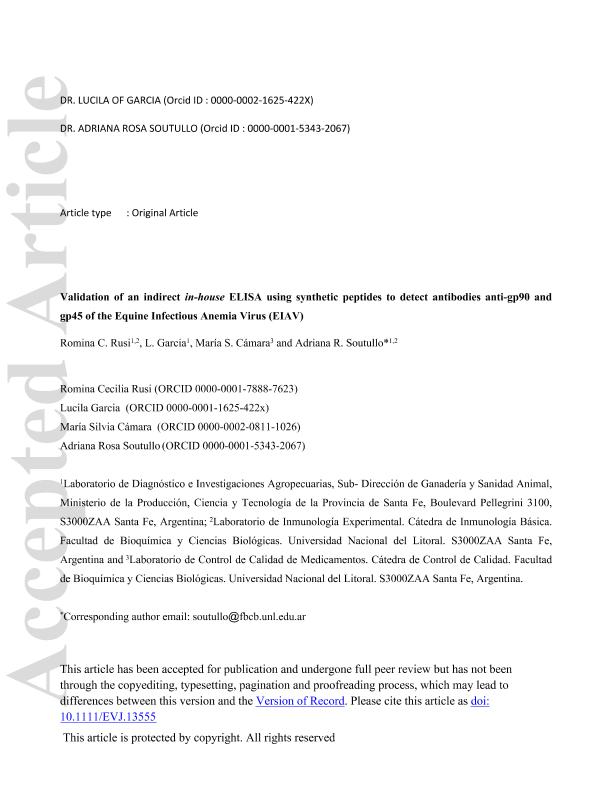Mostrar el registro sencillo del ítem
dc.contributor.author
Russi, Romina Cecilia

dc.contributor.author
García, Lucila

dc.contributor.author
Cámara, María Silvia

dc.contributor.author
Soutullo, Adriana Rosa

dc.date.available
2023-07-12T14:03:28Z
dc.date.issued
2022-01
dc.identifier.citation
Russi, Romina Cecilia; García, Lucila; Cámara, María Silvia; Soutullo, Adriana Rosa; Validation of an indirect in-house ELISA using synthetic peptides to detect antibodies anti-gp90 and gp45 of the equine infectious anaemia virus; Equine Veterinary Journal Ltd; Equine Veterinary Journal; 55; 1; 1-2022; 111-121
dc.identifier.issn
0425-1644
dc.identifier.uri
http://hdl.handle.net/11336/203439
dc.description.abstract
Background: Equine infectious anaemia (EIA) is controlled by the identification of seropositive animals. The official diagnostic method is the agar gel immunodiffusion (AGID) test, which detects antibodies against a viral core protein (p26). Although AGID is inexpensive and specific, the report of results takes considerable time and the test has low analytical sensitivity. Objective: To validate our in-house indirect ELISAgp90/45, following the World Organization of Animal Health (OIE) criteria. Study design: Test validation. Methods: Synthetic peptides gp90 and gp45 were used as antigens in ELISAgp90/45. Tests used for validation, calibration and linear working operating range, analytical and diagnostic sensitivity and specificity, repeatability and reproducibility were assessed by comparing them with the AGID test and using 1844 equine sera grouped into five different panels. Results: We were able to replace the National References Sera with our Internal Reference Sera. ELISAgp90/45 had acceptable repeatability and reproducibility. Analytical sensitivity of the ELISAgp90/45 was 800 times greater than that of AGID test for positive sera and 400 times greater for weak positive sera. ELISAgp90/45 also showed optimal analytical specificity, since no cross-reactivity was detected with antibodies against other equine viruses. One sample was positive by AGID test and negative by ELISAgp90/45. ELISAgp90/45 was performed using 243 EIA positive and 878 negative equid sera, and showed a diagnostic sensitivity of 99.59% [CI 97.73%-99.99%] and a diagnostic specificity of 90.32% [CI 88.17%-92.19%], compared to AGID test; thus, it was demonstrated to be a robust test. Main limitations: Samples were derived from naturally infected equid populations showing heterogeneous clinical states: therefore, their status was uncertain and some horses were sampled more than once. The AGID test may not be the most useful gold standard. Conclusion: ELISAgp90/45 is a useful tool for the diagnosis of EIAV infection and meets validation requirements established by the OIE.
dc.format
application/pdf
dc.language.iso
eng
dc.publisher
Equine Veterinary Journal Ltd

dc.rights
info:eu-repo/semantics/openAccess
dc.rights.uri
https://creativecommons.org/licenses/by-nc-sa/2.5/ar/
dc.subject
AGID TEST
dc.subject
ELISA
dc.subject
EQUINE INFECTIOUS ANAEMIA
dc.subject
HORSE
dc.subject
OIE VALIDATION
dc.subject
SYNTHETIC PEPTIDES
dc.subject.classification
Enfermedades Infecciosas

dc.subject.classification
Ciencias de la Salud

dc.subject.classification
CIENCIAS MÉDICAS Y DE LA SALUD

dc.title
Validation of an indirect in-house ELISA using synthetic peptides to detect antibodies anti-gp90 and gp45 of the equine infectious anaemia virus
dc.type
info:eu-repo/semantics/article
dc.type
info:ar-repo/semantics/artículo
dc.type
info:eu-repo/semantics/publishedVersion
dc.date.updated
2023-07-07T19:13:25Z
dc.journal.volume
55
dc.journal.number
1
dc.journal.pagination
111-121
dc.journal.pais
Reino Unido

dc.description.fil
Fil: Russi, Romina Cecilia. Consejo Nacional de Investigaciones Científicas y Técnicas. Centro Científico Tecnológico Conicet - Mendoza. Instituto de Medicina y Biología Experimental de Cuyo; Argentina. Universidad Nacional del Litoral. Facultad de Bioquimica y Ciencias Biologicas. Laboratorio de Inmunologia Experimental.; Argentina. Gobierno de la Provincia de Santa Fe. Ministerio de la Producción, Ciencia y Tecnología. Laboratorio de Diagnóstico e Investigaciones Agropecuarias; Argentina
dc.description.fil
Fil: García, Lucila. Consejo Nacional de Investigaciones Científicas y Técnicas. Centro Científico Tecnológico Conicet - Rosario. Instituto de Biología Molecular y Celular de Rosario. Universidad Nacional de Rosario. Facultad de Ciencias Bioquímicas y Farmacéuticas. Instituto de Biología Molecular y Celular de Rosario; Argentina. Gobierno de la Provincia de Santa Fe. Ministerio de la Producción, Ciencia y Tecnología. Laboratorio de Diagnóstico e Investigaciones Agropecuarias; Argentina
dc.description.fil
Fil: Cámara, María Silvia. Universidad Nacional del Litoral. Facultad de Bioquímica y Ciencias Biológicas; Argentina
dc.description.fil
Fil: Soutullo, Adriana Rosa. Gobierno de la Provincia de Santa Fe. Ministerio de la Producción, Ciencia y Tecnología. Laboratorio de Diagnóstico e Investigaciones Agropecuarias; Argentina. Universidad Nacional del Litoral. Facultad de Bioquimica y Ciencias Biologicas. Laboratorio de Inmunologia Experimental.; Argentina
dc.journal.title
Equine Veterinary Journal

dc.relation.alternativeid
info:eu-repo/semantics/altIdentifier/url/https://onlinelibrary.wiley.com/doi/10.1111/evj.13555
dc.relation.alternativeid
info:eu-repo/semantics/altIdentifier/doi/http://dx.doi.org/10.1111/evj.13555
Archivos asociados
